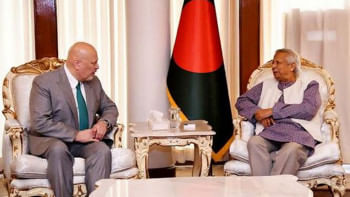Dark Waters

What was supposed to be a festive holiday, turned into a nightmare for Jamalur Hasan. He had arrived home from Dhaka in Kawkhali upazila of Pirojpur district on a seven-day leave to celebrate Eid with his wife, only son and parents. “I went out to the bazaar to buy beef and rice for the Eid feast at around 12 pm. My wife was busy in the kitchen. My son Rakib went out to play with his friends—and that's when it happened,” he recalls.
To escape the heat, Rakib and his friends decided to take a bath in the nearby pond. As the monsoon had arrived early this year, the pond was full to the brim. The steps of the ghat were covered with algae, which made them extremely slippery. Rakib and another friend of his slipped and fell into the pond.

Unfortunately, Rakib's other friends, standing on the ghat in waist-deep water, failed to realise the gravity of the situation—they thought Rakib was pranking them by imitating a fall. Although Rakib's friend managed to lift his head out of the water, Rakib could not.
“When I resurfaced, I thought Rakib was already up. The water was murky so I could not see anything. But when I could not see Rakib on the ghat I dived again,” says Arefin Alam, Rakib's friend. However, rescuing Rakib was too difficult for nine-year-old Arefin. He cried for help but by the time his friends came to rescue him, it was too late.
Rakib, who didn’t know how to swim, was rescued unconscious and he was terribly short of breath. “His body was very cold. His body was shivering. He must have struggled a lot to lift his head. He passed away on the way to the hospital,” says a weeping Jamalur.
Rakib's death is not an isolated case of accidental drowning. Every day, 40 children die from drowning in Bangladesh. And, every year, 14,438 children in Bangladesh lose their lives in this way. In fact, drowning is the leading cause of child mortality in Bangladesh. According to Bangladesh Health and Injury Survey (BHIS) 2016, more children died from drowning than of diseases like pneumonia, measles or ailments caused by malnutrition. The survey revealed that most drownings occur between nine am and two pm in ponds or ditches located within 20 metres of the residence when children are left unsupervised by their caregivers engaged in household chores. As many as 80 percent of these drownings occur in rural areas where children are more exposed to water bodies like ponds, ditches and rivers.
“We don't have piped water sources in the rural areas. Ponds, ditches and rivers are the sources of water and sanitation in these areas. On the other hand, the concept of day-care centre is also an unfamiliar one in the rural areas. When parents are busy with their daily work, their children, left unsupervised, become extremely vulnerable to drowning,” comments Dr Aminur Rahman, director, International Drowning Research Centre, Centre for Injury Prevention and Research, Bangladesh (CIPRB).
Dr Rahman has been researching on drowning prevention for more than two decades. He says, “Drowning can be prevented if children of age group 1-4 year can be kept under supervision from 9 am to 2 pm and children of 5+ years can be taught swimming. Learning to swim works as a vaccine against drowning.”
As a part of Dr Amin's research projects, CIPRB has set up 3000 day-care centres where around 65,000 children, one to four years old, remain engaged in different kinds of learning and playful activities from nine am to two pm. On the other hand, Dr Rahman has also devised low-cost community swimming centres. “These swimming centres are made of a submerged bamboo platform supported by several bamboo posts. A barrier made of bamboo posts keep the children safe inside the platform. In this centre, children can learn swimming and primary rescue techniques safely in an extremely cost-effective way,” says Dr Amin.
Due to lack of interest from the government, initiatives like setting up day-care centres in the rural areas, installing low-cost community swimming centres or introducing swimming lessons in the formal primary and secondary level education were never considered seriously. The government's initiative to address this silent epidemic, unfortunately, is still in its primary stage. Professor Dr AHM Enayet Hossain, additional director general (planning and development), Directorate General of Health Services, says, “Drowning prevention programme requires a lot of initiatives from different departments. For instance, to establish day-care centres, Ministry of Women and Children Affairs and Local Government Engineering Division need to be engaged. Ministry of Youth and Sports can impart training sessions on survival swimming. Again, to introduce swimming in the formal curriculum involves Ministry of Education.”
According to Professor Dr Enayet, DGHS has collected data related to drowning through BHIS 2016 and is currently preparing the National Drowning Prevention Strategy and Action Plan. “We are trying to develop a framework of our future initiatives and the coordination mechanism of different government and non-government offices,” he comments.
Nevertheless, experts like Dr Rahman thinks that this policy paper is still a considerable improvement. “In 2006, government officials didn't even know about drowning as a major cause of child mortality. As a result, it took a long time to convince them that it was important to address this issue. However, once the strategy paper is completed, we shall get a guideline to implement a countrywide drowning prevention programme,” states Dr Rahman.
Bangladesh is considered a top achiever of Millennium Development Goals and now it wants to be another top achiever of the Sustainable Development Goals. In both of these, reduction of child mortality was highly prioritised. And yet, every monsoon and in fact throughout the year, thousands of children like Rakib will die, whose lives could be saved if we could implement some simple, low-cost but effective awareness raising and educational programmes throughout the country.
The writer can be contacted at shahnawaz.khan@thedailystar.net






Comments